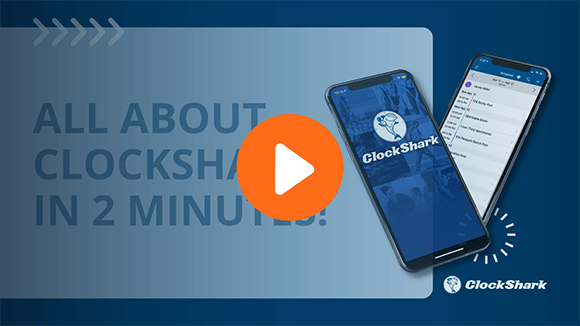What is a Timesheet?
Simply put, a timesheet is a document that records employees' hours worked. The time recorded can include paperwork, clients, project stages, tasks, meetings, and more. Timesheets come in various formats, such as paper, Excel spreadsheets, and digital forms. The purpose of the timesheet is to document accurate hours for payroll and compliance. It is vital for your business to have clear and organized timesheets.
But timesheets are more than that (that’s why we’ve written this article, after all.) From the basics of collecting time worked, timesheets are vital tools for your business to use; by tracking hours, overtime, and breaks, timesheets collect invaluable insights about job costs, productivity, and overall efficiency. The more accurate the information, the more transparent your costs and hours become.
How Does a Timesheet Work?
Timesheets come in many formats, but all timesheets follow the same formula. Using paper, spreadsheets, or digital forms, employees record the date, start, and end times of their jobs/shifts and provide the total hours worked for a shift. Many timesheets collect weekly, biweekly, or monthly data in one document, providing an overview of hours worked and the necessary details.
Timesheets can record other details essential for compliance, such as breaks and overtime, to provide a record and reference.
Each business differs in the format employees use, the amount recorded, and the time period for the total timesheet. How timesheets are recorded, submitted, and approved depends on your business and the method of time tracking, such as manual punchcards or digital clock-in on a time-tracking app.
Timesheets are then passed onto payroll to process the hours and pay the employee their earnings. The documents are stored as a record and proof that the business follows labor laws and regulations.
Key Elements in a Timesheet
Timesheets come in various formats, and several key elements make a proper timesheet. As timesheets are records, every timesheet requires specific details, no matter how simple or complex.
The basic details for a timesheet include:
- name of the employee
- the date
- the start and end times of the work
- total hours worked
The more identifying details on a timesheet, the better, as the last thing you want to do is mix up employees! Some businesses use unique employee IDs to ensure that the timesheets remain consistent.
Additional elements in a timesheet include:
- Department/Team of the employee
- Name of the employee’s supervisor or manager
- Breaks: such as meal times and unpaid breaks
- Tasks: what the employee worked on during the shift
- Overtime: some timesheets can automatically calculate overtime hours
- Signatures: for both the employee and their manager/supervisor to sign off on the timesheet
- Employee initials: to confirm times as correct and filled in by them
The complexity and details of a timesheet are up to the business, but at the bare minimum, it needs to show who worked when and for how long.
How Digital Timesheets Simplify the Process
For businesses with mobile work teams, paper timesheets have long been a popular option. It’s easy to see why: a paper timesheet can go wherever workers go, it doesn’t require any special equipment, and it’s easy to fill out. However, despite their accessibility and portability, paper timesheets have plenty of downsides. They can easily get lost or damaged, and it takes a lot of time to transfer them to payroll, opening the process up to mistakes with double handling.
Digital timesheets avoid the issues of physical timesheets, as they can be filled in and shared digitally. They’re much easier to change and use, and Excel spreadsheets are a popular option for businesses to first try digital timesheets.
Excel timesheets do have downsides, mainly the same possibility of manual errors and more time spent in administration to transfer the details to payroll. They’re a big step up from paper, but still have issues.
Job management software offers the best digital timesheets. These timesheets are tailor-made to be customizable, easy to use, and integrated with other essentials such as payroll and HR. Combined with time-tracking tools, such as clock-in and clock-out apps or automatic time-tracking, data is seamlessly translated into a timesheet.
ClockShark’s powerful time-tracking tools combined with easy-to-use software enhance the accuracy and detail of timesheets. With ClockShark, employee timesheets reflect highly accurate time-tracking, overtime calculations, and seamlessly integrate with payroll and HR tools.
Your Free Employee Timesheet Template
The best place to start with a timesheet is to use a template. Templates are a great introduction to exploring digital timesheets and provide everything you need to get started immediately. Just download ClockShark’s timesheet templates and create master copies tailored to your business.
Download our free timesheet templates to get started. Pick one or try them all to see which fits your needs and your business best.
Already have the details, but no timesheet? Try ClockShark’s timesheet calculator and generate a free timesheet with options for week length, overtime and base rate of pay.
Make your Timesheets Work for You
Paper, Excel, or software: ultimately, the choice is up to you, and starting with timesheet templates is an excellent way to shift into digital timesheets. But if you want timesheets that work hard, time-tracking software is the best option.
Want timesheets that work with a time clock app, calculate overtime, have security controls, and integrate with payroll without double-handling? ClockShark’s job management software has it covered with our easy-to-use features, available on any device. Sign up for ClockShark today and take back your time.





